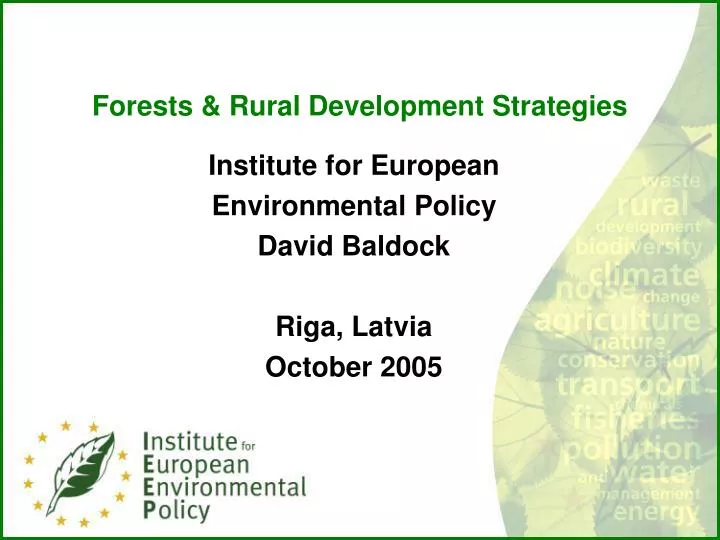
Forests & Rural Development Strategies
Presentation Transcript
Forests & Rural Development Strategies Institute for European Environmental Policy David Baldock Riga, Latvia October 2005
Forestry & Rural Development • Varying levels of forested land and recognition of forestry in the scope of rural development measures • Forestry often seen in the past as an entirely separate or second order land use • More integrated and balanced approach being adopted e.g. in new EU Policy on Rural Development • Integration becoming a more important theme in rural development and in agriculture, e.g. emphasis on multifunctionality • Drivers of integration include environmental priorities, employment, privatisation of state forests, debates over grazing and land abandonment, new focus on energy and biofuels
Woodlands and Forestry: Importance in EU Member States • Ownership of EU25 Forests • 40% public ownership • 92% in Estonia, 84% in Czech Republic, 66% in Ireland • 43% in UK • 60% private ownership • 92% in Portugal, 82% in Austria, 17% in Poland • 57% in UK
Woodlands and Forestry: Importance in EU Member States • Ownership of EU25 Forests (cont) • Approx 12m private forest owners in EU15 • Approx 3m private forest owners in 10 new Member States • Average size: • Public forested areas: >1000ha • Private forested areas: 13ha
EU Involvement in Forestry • Effectively an outgrowth of agricultural and cohesion policy: no independent legal foundation. • International Level • EU participates in Ministerial Conferences on the Protection of Forests in Europe (MCPFE) • Overall Planning and Strategy • EU Forestry Strategy (being revised) • Funding of Forestry • Via Structural Funds • Via RDR/EAFRD • Trade Policy • Includes tropical forest issues • e.g. Forest Law Enforcement, Governance and • Trade (FLEGT)
Forestry in the Agenda 2000 perspective . Non productive & amenity investments Extension of forest resource base • . • . Forestry budget 4 807 Million EUR (9.8%of RD budget ) Example: Afforestation Programmes Example: Prevention of forest fires Climate change Natura 2000, general biodiversity WFD Example: Carbon sequestration, GHG emissions, Energy from forest biomass & wood waste biomass Example: Forest management in Natura 2000 areas Ecological stability of forest Example: Protection of freshwater resources
Main components of the pre-reform CAPin the Pillar I & II expenditure Source: European Commission, DG Budget
Current Forestry measures • Afforestation has been the main forestry related measure in: Ireland, the UK, Denmark, Italy, Portugal • More emphasis on ‘other forestry measures’ in e.g: Luxembourg, Austria, Sweden, France • Italy and Spain - the largest afforestation expenditure in their RDPs 2000-2006, with significant support planned for other forestry measures. • Germany - significant forestry component, with more resources dedicated to ‘other forestry measures’ than to afforestation.
Breakdown by measures (1992-1999) :Forestry Regulation (EEC) N° 2080/92
The Toolbox for Axis II • Two blocks of measures targeting sustainable use of: • Agricultural land: • Less Favoured Areas; Natura 2000; Water • Framework Directive; Agri-Environment; animal • welfare; non- productive investments • Forestry Land: • Afforestation; agro-forestry; Natura 2000; forest • environment; restoring forestry potential / • prevention; non-productive investments
EAFRD Axis II measures: • Measures targeting the sustainable use of agricultural • land through: • i) natural handicap payments to farmers in mountain areas; • (ii) payments to farmers in areas with handicaps, other than mountain areas; • (iii) Natura 2000 payments and payments linked to Directive 2000/60/EC; • (iv) agri-environment payments (compulsory); • (v) animal welfare payments; • (vi) support for “non-productive” investments;
EAFRD Axis II measures cont: • Measures targeting the sustainable use of forestry land through: • (i) first afforestation of agricultural land; • (ii) first establishment of agroforestry systems on agricultural land; • (iii) first afforestation of non agricultural land; • (iv) Natura 2000 payments in wooded areas; • (v) forest-environment payments; • (vi) restoring forestry potential and introducing prevention actions; • (vii) support for “non-productive” investments.
Axis II measures can be used to: • Reduce problems such as soil erosion • Improve air quality • Reduce greenhouse gas emissions and help to combat climate change • Improve water quality of e.g. of lakes and rivers and help to reduce risk of flooding • Help maintain and enhance important habitats and species • Manage and maintain valuable landscapes and cultural features • Facilitate access to, and recreation opportunities in, the countryside • Contribute to social and economic objectives as well as environmental ones e.g. by sustaining or creating employment, preventing land abandonment etc.
Environmental benefits of forestry: • Appropriate forestry suited to site conditions is important for biodiversity and climate change mitigation; • It can also help to control erosion, assist water management in catchments, enrich the landscape, offer recreational opportunities and provide a source of income; • Less than 1% of EU forests are pristine habitat with >66% semi-natural; • Some 127 million ha (12%) of EU forests are protected and 29% of Natura 2000 designations are categorised as forest habitats; • Poor forest management can lead to a wide range of environmental problems e.g. erosion, biodiversity loss


















